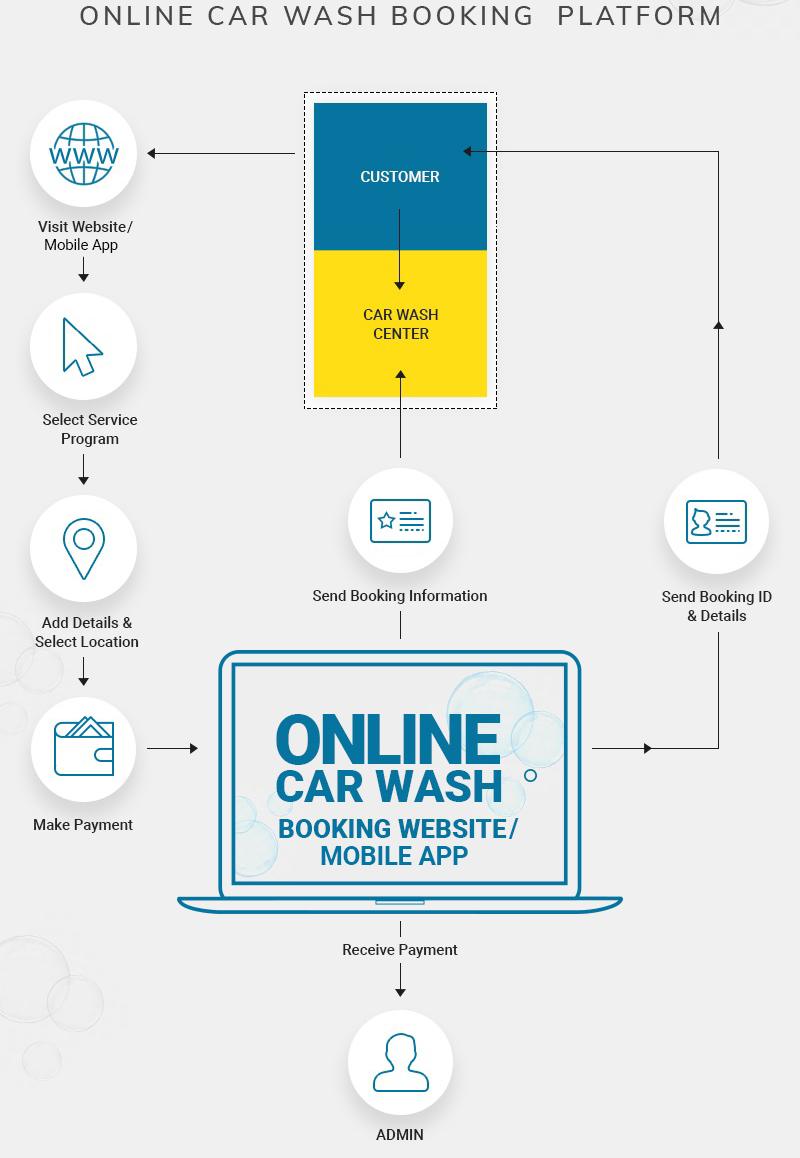Washigniter – Vehicle Wash Booking Management System
The easy and feature-rich Vehicle Wash Booking Management System may be used to handle reservations for vehicle washes. Business owners can easily manage bookings online utilizing the admin panel’s numerous features. This is really user-friendly and totally responsive. This may be used to integrate with any current website.
A Vehicle Wash Booking Management System is a software application designed to streamline and automate the process of booking and managing vehicle wash services. This system provides a convenient and efficient way for customers to schedule appointments, select specific services, and track the progress of their vehicle wash. At the same time, it helps car wash businesses optimize their operations and improve customer satisfaction.
One of the key features of a Vehicle Wash Booking Management System is the online booking portal. Customers can access this portal through a website or a mobile application, allowing them to book a vehicle wash at their convenience. The portal usually displays available time slots, allowing customers to select a date and time that suits them. They can also choose from various types of wash services, such as basic wash, premium wash, or specialized treatments like waxing or interior cleaning. This user-friendly interface empowers customers to easily customize their bookings based on their preferences and requirements.
Once a customer makes a booking, the Vehicle Wash Booking Management System automatically updates the schedule and reserves the selected time slot. This helps prevent overlapping appointments and ensures that the car wash staff can efficiently manage their workload. Additionally, the system can send automated confirmation emails or text messages to customers, providing them with all the necessary details about their appointment.
Furthermore, the system offers benefits to both customers and car wash businesses by integrating various payment options. Customers can make secure online payments using credit or debit cards, mobile wallets, or other electronic payment methods. This eliminates the need for customers to carry cash and simplifies the payment process. For car wash businesses, this ensures timely payment collection and reduces the risk of payment discrepancies.
From the car wash business’s perspective, a Vehicle Wash Booking Management System provides comprehensive tools for managing operations. It allows managers to monitor and control the overall workflow, ensuring that appointments are evenly distributed throughout the day and that the necessary resources, such as staff and equipment, are allocated efficiently. The system can generate reports and analytics that provide insights into business performance, such as the number of bookings, revenue generated, and customer feedback. This data helps managers make informed decisions and implement strategies to enhance customer satisfaction and maximize profitability.
Another important aspect of a Vehicle Wash Booking Management System is customer relationship management (CRM). The system can maintain a database of customer information, including contact details, vehicle details, and service history. This enables car wash businesses to personalize their services and offer loyalty programs or discounts to valued customers. Additionally, the system can send automated reminders or promotional messages to customers, keeping them engaged and encouraging repeat business.
Current Version New Features
-
Minor bugs has been removed
Minor bugs being removed refers to the process of identifying and fixing small issues or glitches in software, applications, or systems. Bugs are defects or errors in the code that can cause unintended behavior or problems in the functioning of the software.
When developers create software, it’s common for bugs to be present, even after thorough testing. Minor bugs are typically less severe compared to major bugs, which can cause significant issues and disruptions. Minor bugs may include cosmetic problems, user interface inconsistencies, spelling errors, minor performance issues, or other small glitches that do not severely impact the functionality of the software.
To address these minor bugs, developers typically follow a bug-fixing process. This involves identifying and reproducing the bug, analyzing the code to understand its cause, and then implementing the necessary changes to correct the issue. Once the bug has been resolved, the updated code is tested to ensure that the fix did not introduce any new problems.
-
SMS gateway integration
SMS gateway integration refers to the process of connecting an application or system with an SMS gateway provider’s infrastructure to enable the sending and receiving of SMS (Short Message Service) messages. An SMS gateway acts as a bridge between the application and the mobile network, allowing the application to send SMS messages to mobile devices and receive SMS messages from them.
-
Dynamic email templates
Dynamic email templates enable the customization of email content based on different factors. This can include variables such as recipient demographics, preferences, past interactions, or any other relevant data. By tailoring the content, the template can provide a more relevant and engaging experience for each recipient.
Dynamic email templates enable the customization of email content based on different factors. This can include variables such as recipient demographics, preferences, past interactions, or any other relevant data. By tailoring the content, the template can provide a more relevant and engaging experience for each recipient.
-
Invoice template
An invoice template is a pre-designed document that is used to create professional-looking invoices. It provides a standardized format for businesses to bill their clients or customers for goods or services provided. The template typically includes essential information such as the seller’s and buyer’s details, a unique invoice number, itemized list of products or services, quantities, prices, and the total amount due.
Invoice templates provide a professional and consistent format for invoicing, saving time and effort for businesses. They can be created using software applications like Microsoft Excel, Word, or specialized accounting software. Templates can be customized to suit specific business needs, such as adding branding elements or incorporating specific payment terms.
-
Improved dashboard
An improved dashboard refers to an enhanced version of a graphical user interface (GUI) that provides users with a comprehensive and intuitive view of data, metrics, and key performance indicators (KPIs) relevant to a specific system, project, or organization.
Improved dashboard aims to provide a user-friendly, visually appealing, and data-rich interface that facilitates data exploration, decision-making, and performance monitoring. By presenting information in a clear and customizable manner, it helps users gain actionable insights, monitor progress, and make informed decisions based on real-time data.
-
Assign to employee
Assigning work to an employee refers to the process of allocating specific tasks, projects, or responsibilities to an individual within an organization. It is a crucial aspect of workforce management and plays a significant role in ensuring that work is distributed efficiently and that employees are appropriately utilized based on their skills, expertise, and availability.
By effectively assigning work to employees, organizations can optimize productivity, utilize their workforce efficiently, and ensure that tasks are completed in a timely and effective manner. It also contributes to employee engagement, skill development, and overall organizational success.
-
Service status
Service status refers to the current operational state or condition of a particular service or system. It provides information about whether a service is functioning properly, experiencing issues, or undergoing maintenance. Service status is commonly used by organizations to communicate with their users or customers, allowing them to stay informed about the availability and performance of the services they rely on.
-
User management
User management refers to the process of overseeing and controlling user accounts within a system or organization. It involves various tasks and activities related to creating, modifying, and deleting user accounts, as well as defining their permissions, roles, and access levels. User management is crucial for maintaining security, ensuring proper system utilization, and enabling effective collaboration within an organization.
Backend features
The Vehicle Wash Booking Management System is an essential tool for automating and streamlining the process of scheduling and managing vehicle wash appointments. With its backend features, this system ensures efficient operations, seamless communication, and effective coordination between customers, staff, and resources. In this article, we will explore the various backend features of the Vehicle Wash Booking Management System and how they contribute to the overall functionality and success of the system.
User Management:
One of the fundamental backend features of the system is user management. It allows administrators to manage user accounts, including customer and staff profiles. User management encompasses functionalities such as user registration, login, authentication, and authorization. Through the backend, administrators can create, edit, and delete user accounts, assign roles and permissions, and maintain a secure database of user information.
Booking Management:
The booking management feature handles the entire process of scheduling and managing vehicle wash appointments. Customers can make bookings through a user-friendly interface, specifying their preferred date, time, and type of service. The backend facilitates the storage and organization of these bookings, ensuring that there are no conflicts or overlapping appointments. It also enables staff members to view and manage the bookings, update their status, and send notifications to customers regarding any changes or cancellations.
Service Management:
Efficient service management is crucial for a vehicle wash booking system. The backend feature allows administrators to define and maintain a comprehensive list of available services. This includes different types of washes, detailing options, additional services, and pricing information. By managing services through the backend, administrators can easily modify and update the service offerings as needed, ensuring that customers have accurate and up-to-date information when making their bookings.
Resource Allocation:
The backend feature of resource allocation plays a vital role in optimizing the utilization of available resources such as wash bays, equipment, and staff members. Through the system’s backend, administrators can assign resources to specific time slots based on the bookings received. This ensures that there is no overbooking or underutilization of resources, maximizing operational efficiency. The backend also allows administrators to track the availability and maintenance schedules of equipment, ensuring smooth operations and minimizing downtime.
Communication and Notifications:
Effective communication is essential for providing a seamless customer experience. The backend of the Vehicle Wash Booking Management System facilitates communication between customers, staff members, and administrators. It enables automated notifications and reminders to be sent to customers regarding their upcoming appointments, changes in schedule, or other relevant updates. Staff members can also receive notifications regarding new bookings, changes, or any specific instructions from customers. The backend keeps a record of all communication, ensuring transparency and accountability.
Reporting and Analytics:
Backend features in the Vehicle Wash Booking Management System also include reporting and analytics capabilities. These features enable administrators to generate comprehensive reports on various aspects of the system, such as bookings, revenue, customer feedback, and resource utilization. By analyzing this data, administrators can gain valuable insights into the performance of the system, identify trends, and make data-driven decisions to improve overall efficiency and customer satisfaction.
Integration and Scalability:
To enhance the system’s functionality and accommodate future growth, backend features should allow for easy integration with other systems and scalability. The backend should support APIs (Application Programming Interfaces) that enable seamless integration with payment gateways, customer relationship management (CRM) tools, or other third-party applications. Additionally, the system should be scalable to handle increased user loads and additional features as the business expands.
The backend features of the Vehicle Wash Booking Management System provide the necessary tools and functionalities to streamline operations, enhance customer experience, and optimize resource utilization. From user management to service allocation, communication to reporting, these backend features work in harmony to ensure a smooth and efficient vehicle wash booking process. By leveraging the power of technology and automation, this system contributes
Frontend Features
The frontend of a Vehicle Wash Booking Management System plays a crucial role in providing a seamless and user-friendly experience to customers. It encompasses the visual and interactive components that users interact with when booking and managing their vehicle wash appointments. In this article, we will explore the various frontend features that make up an efficient and effective Vehicle Wash Booking Management System.
User Registration and Login:
The frontend of the system should include a user registration and login feature. It allows customers to create accounts and securely log in to access their booking details and preferences. A well-designed registration form should collect necessary information such as name, contact details, and vehicle information. The login functionality ensures that users can easily access their accounts and view their booking history, making the process more convenient and personalized.
Service Selection and Customization:
The frontend should provide an intuitive interface for customers to select and customize their desired services. This can include options for various types of vehicle washes, additional services (such as interior cleaning or waxing), and different service packages. The frontend should present clear descriptions, pricing details, and visually appealing representations of each service to help customers make informed decisions. It should also allow users to customize their booking by selecting preferred time slots, specific service providers, or any special instructions.
Calendar and Booking Management:
An effective frontend should incorporate a user-friendly calendar feature that displays available time slots for vehicle wash appointments. Customers should be able to view the calendar, select their preferred date and time, and book an appointment with a few clicks. The frontend should also allow users to manage their existing bookings, providing options to reschedule or cancel appointments if necessary. Real-time updates on available slots and automatic confirmation notifications help enhance user experience and minimize booking conflicts.
Payment Integration:
To streamline the payment process, the frontend should integrate a secure and convenient payment gateway. Customers should be able to choose their preferred payment method (credit card, digital wallets, etc.) and make payments seamlessly without leaving the system. The frontend should display pricing details, confirm payment status, and generate receipts for customers to keep track of their expenses. Implementing industry-standard security measures ensures that customer payment information is protected.
Feedback and Review System:
A robust frontend should include a feedback and review system that allows customers to share their experiences and rate the service. Users should have the ability to leave comments, provide ratings, and offer suggestions for improvement. The frontend can display average ratings and reviews to help potential customers make informed decisions. This feature not only benefits customers but also provides valuable insights for the service providers to enhance their offerings and maintain high standards.
Notifications and Reminders:
To enhance communication and ensure a smooth experience, the frontend should incorporate a notification system. Users should receive real-time notifications and reminders regarding their upcoming appointments, rescheduling options, or any changes in the service availability. These notifications can be sent via email, SMS, or through push notifications in a mobile application. Timely reminders help reduce no-shows and keep customers engaged with the booking system.
Responsive Design:
The frontend of a Vehicle Wash Booking Management System should be designed with responsiveness in mind. It should adapt to different screen sizes and devices, ensuring a consistent and user-friendly experience across desktops, laptops, tablets, and smartphones. The frontend should be optimized for quick loading times and intuitive navigation, regardless of the device used. Responsive design improves accessibility and accommodates the preferences of a wide range of users.
The frontend features of a Vehicle Wash Booking Management System are critical for providing a seamless and user-friendly experience to customers. The registration and login system, service selection and customization options, calendar and booking management, payment integration, feedback and review system, notifications and reminders, and responsive design all contribute to a well-rounded and efficient booking system. By incorporating these features, businesses can streamline their operations, improve customer satisfaction, and establish a strong online presence in the competitive vehicle wash industry.
Conclusion
In conclusion, a Vehicle Wash Booking Management System simplifies the process of scheduling and managing vehicle wash services for both customers and car wash businesses. It provides a user-friendly interface for customers to book appointments, select services, and make payments online. For car wash businesses, the system offers tools for optimizing operations, tracking performance, and maintaining customer relationships. By automating and streamlining the booking process, this system enhances efficiency, improves customer satisfaction, and ultimately contributes to the success of car wash businesses.









